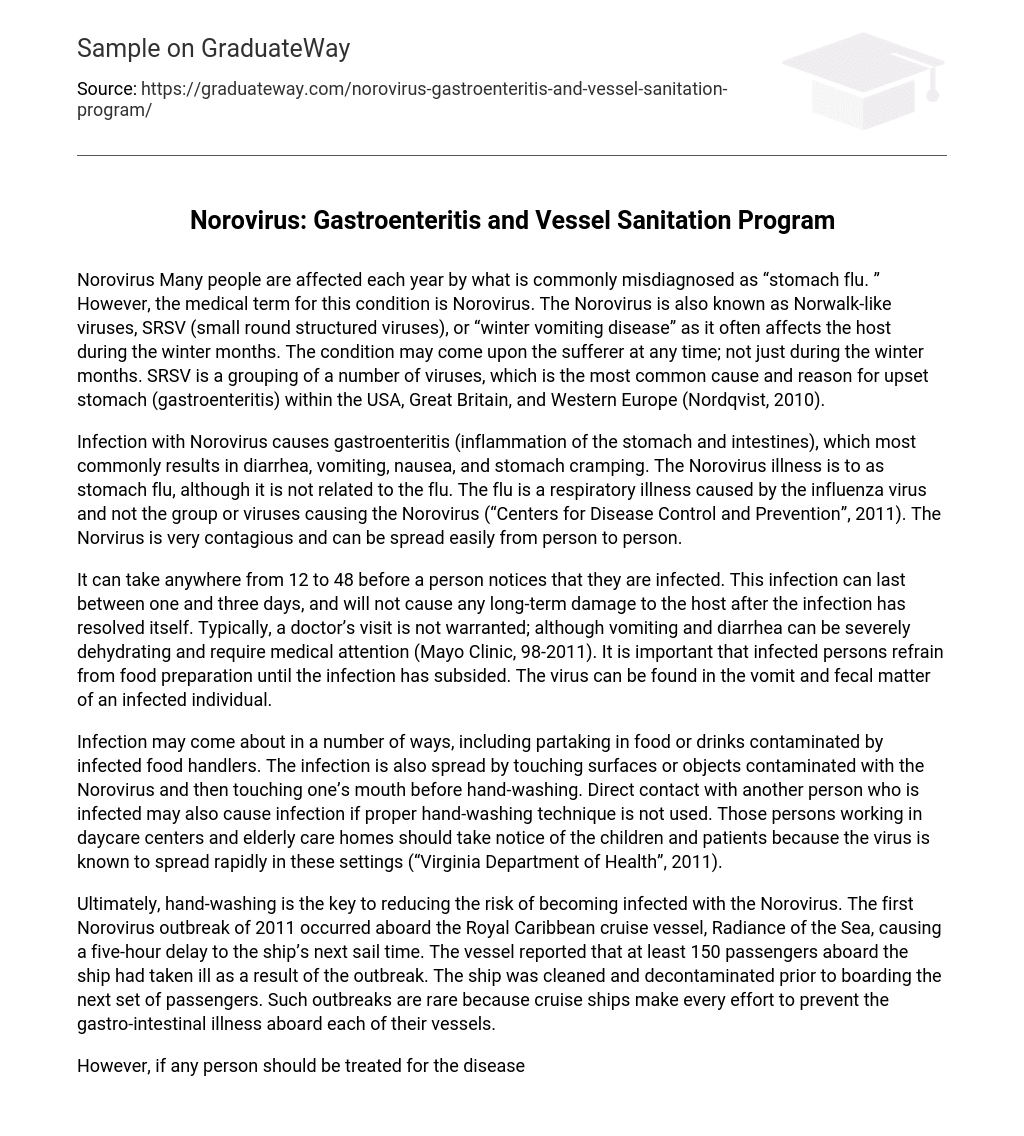Norovirus Many people are affected each year by what is commonly misdiagnosed as “stomach flu. ” However, the medical term for this condition is Norovirus. The Norovirus is also known as Norwalk-like viruses, SRSV (small round structured viruses), or “winter vomiting disease” as it often affects the host during the winter months. The condition may come upon the sufferer at any time; not just during the winter months. SRSV is a grouping of a number of viruses, which is the most common cause and reason for upset stomach (gastroenteritis) within the USA, Great Britain, and Western Europe (Nordqvist, 2010).
Infection with Norovirus causes gastroenteritis (inflammation of the stomach and intestines), which most commonly results in diarrhea, vomiting, nausea, and stomach cramping. The Norovirus illness is to as stomach flu, although it is not related to the flu. The flu is a respiratory illness caused by the influenza virus and not the group or viruses causing the Norovirus (“Centers for Disease Control and Prevention”, 2011). The Norvirus is very contagious and can be spread easily from person to person.
It can take anywhere from 12 to 48 before a person notices that they are infected. This infection can last between one and three days, and will not cause any long-term damage to the host after the infection has resolved itself. Typically, a doctor’s visit is not warranted; although vomiting and diarrhea can be severely dehydrating and require medical attention (Mayo Clinic, 98-2011). It is important that infected persons refrain from food preparation until the infection has subsided. The virus can be found in the vomit and fecal matter of an infected individual.
Infection may come about in a number of ways, including partaking in food or drinks contaminated by infected food handlers. The infection is also spread by touching surfaces or objects contaminated with the Norovirus and then touching one’s mouth before hand-washing. Direct contact with another person who is infected may also cause infection if proper hand-washing technique is not used. Those persons working in daycare centers and elderly care homes should take notice of the children and patients because the virus is known to spread rapidly in these settings (“Virginia Department of Health”, 2011).
Ultimately, hand-washing is the key to reducing the risk of becoming infected with the Norovirus. The first Norovirus outbreak of 2011 occurred aboard the Royal Caribbean cruise vessel, Radiance of the Sea, causing a five-hour delay to the ship’s next sail time. The vessel reported that at least 150 passengers aboard the ship had taken ill as a result of the outbreak. The ship was cleaned and decontaminated prior to boarding the next set of passengers. Such outbreaks are rare because cruise ships make every effort to prevent the gastro-intestinal illness aboard each of their vessels.
However, if any person should be treated for the disease and are arriving to a U. S. Port, the vessel must report the incident to the CDC’s Vessel Sanitation Program division (Sloan, 2011). Most times, it is not known how the disease is spread, but it can be presumed that this type of outbreak may be the result of close living quarters aboard the ship, improper hand washing, or direct contact with someone who is infected with the Norovirus (“Centers for Disease Control and Prevention”, 2011).
In summary, the Norovirus is an illness that is completely preventable. This illness plagues many people throughout the year, but is often seen more frequently during the winter season. It typically lasts no more than three days and does not require medical attention. As mentioned, hand-washing is the key to limiting or preventing the risk of contracting the gastro-intestinal illness. References Centers for Disease Control and Prevention. (2011, Oct 03). Retrieved October 03, 2011, from Centers for Disease Control and Prevention website: http://www. dc. gov/ncidod/dvrd/revb/gastro/norovirus-foodhandlers. htm The Minnesota Department of Health. (2011). Retrieved October 3, 2011, from Minnesota Department of Health website: http://www. health. state. mn. us/divs/idepc/diseases/norovirus/prevention. html Nordqvist, C. (2010, Febuary 13). MediLexicon International Ltd. Retrieved Oct 3, 2011, from Medical News Today: http://www. medicalnewstoday. com Sloan, G. (2011, January 01). 2011 USA TODAY, a division of Gannett Co. Inc. Retrieved October 03, 2011, from USA Today Travel website: http://travel. satoday. com Mayo Clinic. (98-2011, August 02). 1998-2011 Mayo Foundation for Medical Education and Research. Retrieved October 3, 2011, from Mayo Foundation for Medical Education and Research website: http://www. mayoclinic. com/health/norovirus/DS00942 The Virginia Department of Health. (2011). Retrieved from http://www. vdh. virginia. gov/epidemiology/factsheets/norovirus. htm Zimmerman, R. (2011, Febuary 23). WebMD LLC. Retrieved Oct 3, 2011, from Medscape website: http://www. medscape. com/viewarticle/737884





